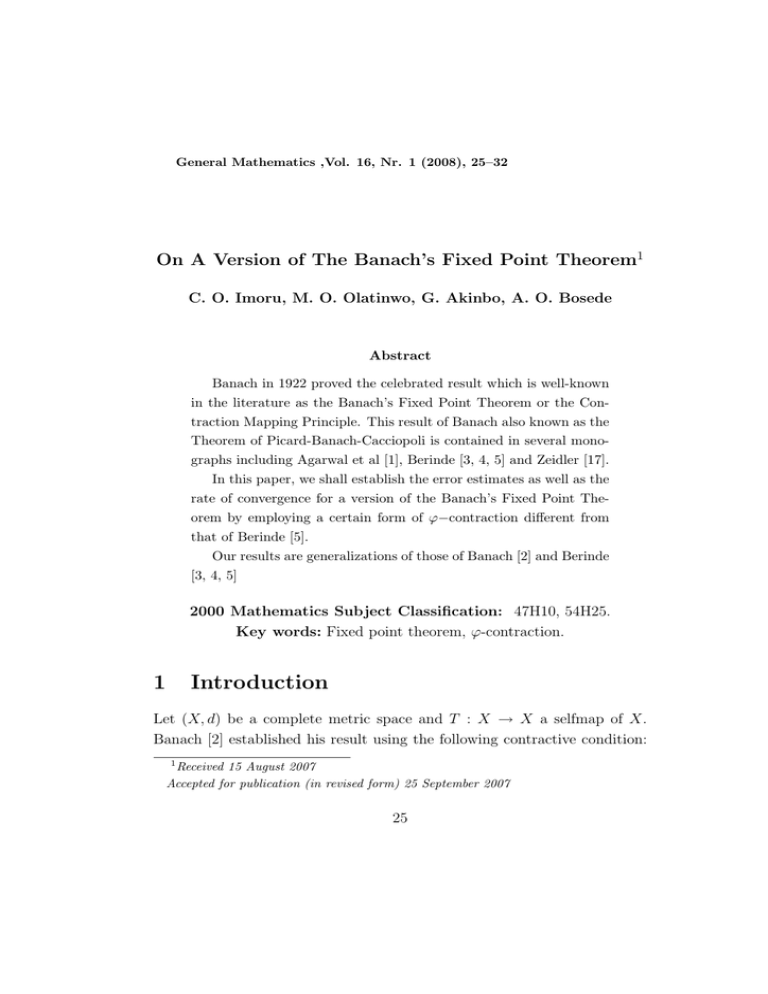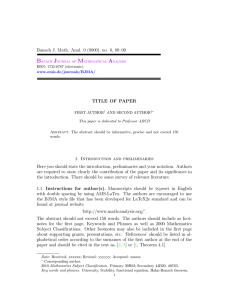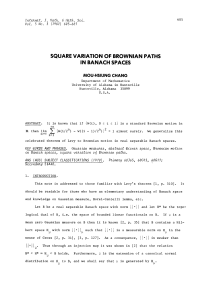On A Version of The Banach’s Fixed Point Theorem
advertisement

General Mathematics ,Vol. 16, Nr. 1 (2008), 25–32
On A Version of The Banach’s Fixed Point Theorem1
C. O. Imoru, M. O. Olatinwo, G. Akinbo, A. O. Bosede
Abstract
Banach in 1922 proved the celebrated result which is well-known
in the literature as the Banach’s Fixed Point Theorem or the Contraction Mapping Principle. This result of Banach also known as the
Theorem of Picard-Banach-Cacciopoli is contained in several monographs including Agarwal et al [1], Berinde [3, 4, 5] and Zeidler [17].
In this paper, we shall establish the error estimates as well as the
rate of convergence for a version of the Banach’s Fixed Point Theorem by employing a certain form of ϕ−contraction different from
that of Berinde [5].
Our results are generalizations of those of Banach [2] and Berinde
[3, 4, 5]
2000 Mathematics Subject Classification: 47H10, 54H25.
Key words: Fixed point theorem, ϕ-contraction.
1
Introduction
Let (X, d) be a complete metric space and T : X → X a selfmap of X.
Banach [2] established his result using the following contractive condition:
1
Received 15 August 2007
Accepted for publication (in revised form) 25 September 2007
25
26
C. O. Imoru, M. O. Olatinwo, G. Akinbo, A. O. Bosede
There exists a ∈ [0, 1) (fixed) such that
(1)
d(T x, T y) ≤ ad(x, y),
for any x, y ∈ X.
Condition (1) is called strict contraction (Banach’s contraction condition).
There have been several generalizations of the classical Banach’s fixed point
theorem through different modifications of condition (1). The following
contractive definition was employed by Berinde [4, 5] for the extension of
the Banach’s fixed point theorem: For a selfmap T : X → X, there exists a
ϕ-contraction ϕ : R+ → R+ such that
(2)
d(T x, T y) ≤ ϕ(d(x, y)), ∀ x, y ∈ X,
where ϕ : R+ → R+ is a (c)-comparison function.
The Banach’s Fixed Point Theorem guarantees the existence and uniqueness of the fixed points of nonlinear equations and provides a method for
evaluating these fixed points. The result also ensures both a priori and a
posteriori error estimates as well as the rate of convergence. The result of
Banach [2] is also contained in several monographs and papers including
Berinde [4, 5] and Zeidler [17].
In this work, we shall state a variant of the Banach’s fixed point theorem
and then obtain both a priori and a posteriori error estimates as well as the
rate of convergence for this result using the following general contractive
definition: There exist a constant
L ≥ 0 and β ∈ [0, 1] such that
(3)
d(T x, T y) ≤ ϕ(βd(x, y) + Ld(x, T x)),
for all x, y ∈ X and ϕ : R+ → R+ is a (c)-comparison function.
Condition (3) is a generalization of those of [2, 3, 4, 5] and [16]. Interested
readers are referred to Rhoades [13], Rus [14], Rus etal [15] and others in the
reference section of this paper for various generalizations of the Banach’s
On A Version of The Banach’s Fixed Point Theorem
27
Fixed Point Theorem as well as for different contractive definitions.
The following definitions shall be required in the sequel.
Definition 1.1. A function ϕ : R+ → R+ is called (c)-comparison if it
satisfies:
(i) ϕ is monotone increasing;
(ii) ϕn (t) → 0 as n → ∞, for all t > 0 (ϕn stands for the nth iterate of ϕ);
∞
X
(iii)
ϕn (t) < ∞ for all t > 0.
n=0
We say that ϕ is a comparison function if it satisfies (i) and (ii) only.
Definition 1.2. Let (X, d) be a metric space. A mapping T : X → X is
said to be a ϕ−contraction if there exists a comparison function
ϕ : R+ → R+ such that (2) holds for all x, y ∈ X.
See [4, 5] for both Definition 1.1 and Definition 1.2.
Remark 1.3. If L = 0, and β = 1 in (3), then we obtain (2), whereas we
get (1) from (3) if L = 0, β = 1 and ϕ(u) = au, ∀ u ∈ R+ , a ∈ [0, 1).
Furthermore, we obtain the Zamfirescu contraction condition from condition
(3), if we have ϕ(βd(x, y) + Ld(x, T x)) = k[βd(x, y) + Ld(x, T x)], with
ª
©
c
b
, 1−c
, 0≤δ<1
kβ = δ, kL = 2δ, for some k > 0, where δ = max a, 1−b
(a, b, c are constants involved in Theorem Z of Berinde [3]).
2
Main Result
Our main result is the following:
Theorem 2.1. Let (X, d) be a complete metric space and T : X → X an
operator satisfying (3) with β + L ≤ 1. Suppose that ϕ : R+ → R+ is a
(c)-comparison function such that ϕ(ct) ≤ cϕ(t), c > 0, t ∈ R+ . Then,
(i) T has a unique fixed point, that is, FT = {x∗ };
(ii) The Picard iteration associated to T, i.e., {xn }∞
n=0 defined by
(4)
xn+1 = T xn , n = 0, 1, 2, . . .
28
C. O. Imoru, M. O. Olatinwo, G. Akinbo, A. O. Bosede
converges to x∗ , for any initial guess x0 ∈ X;
(iii) a priori error estimate:
(5)
d(xn , x∗ ) ≤
∞
X
(β + L)n+k ϕn+k (d(x0 , x1 )),
k=0
and a posteriori error estimate:
(6)
d(xn , x∗ ) ≤
∞
X
(β + L)k ϕk (d(xn , xn+1 )),
k=0
(iv) the rate of convergence is given by
d(xn , x∗ ) ≤ β n ϕn (d(x0 , x∗ )).
(7)
Proof. The proofs of (i) and (ii) are similar to those in Berinde [5] and
some other references cited in the reference section of this paper. Hence, it
suffices to establish (iii) and (iv). Now, we have
d(x1 , x2 ) = d(T x0 , T x1 ) ≤ ϕ(Ld(x0 , T x0 ) + βd(x0 , x1 ))
= ϕ(Ld(x0 , x1 ) + βd(x0 , x1 )) ≤ (β + L)ϕ(d(x0 , x1 ))
d(x2 , x3 ) = d(T x1 , T x2 ) ≤ ϕ(Ld(x1 , T x1 ) + βd(x1 , x2 ))
= ϕ(Ld(x1 , x2 ) + βd(x1 , x2 ))
≤ (β + L)ϕ(d(x1 , x2 ))
≤ (β + L)ϕ ((β + L)ϕ(d(x0 , x1 )))
≤ (β + L)2 ϕ2 (d(x0 , x1 ))
In general,
(8)
d(xk , xk+1 ) ≤ (β + L)k ϕk (d(x0 , x1 )).
Therefore, we obtain by using (8) and the triangle inequality that
d(xn , xn+p ) ≤ d(xn , xn+1 ) + d(xn+1 , xn+2 ) + · · · + d(xn+p−1 , xn+p )
≤ (β + L)n ϕn (d(x0 , x1 )) + (β + L)n+1 ϕn+1 (d(x0 , x1 ))
+ · · · + (β + L)n+p−1 ϕn+p−1 (d(x0 , x1 ))
n+p−1
X
(9)
=
(β + L)k+n ϕk+n (d(x0 , x1 )).
k=0
On A Version of The Banach’s Fixed Point Theorem
29
By (ii), xn → x∗ as n → ∞, that is, lim xn = x∗ . Since (X, d) is complete,
n→∞
then x∗ ∈ X.
To prove the a priori error estimate, we take the limit of both sides of (9)
as p → ∞ and apply the continuity of the metric, i.e.,
lim d(xn , xn+p ) = d(xn , x∗ ) = d(x∗ , xn ) = lim d(xn+p , xn )
p→∞
p→∞
∞
X
≤
(β + L)k+n ϕk+n (d(x0 , x1 )),
k=0
giving us (5).
To prove the a posteriori error estimate, we have
d(xn+1 , xn+2 ) = d(T xn , T xn+1 ) ≤ ϕ(Ld(xn , T xn ) + βd(xn , xn+1 ))
= ϕ(Ld(xn , xn+1 ) + βd(xn , xn+1 ))
= ϕ((β + L)d(xn , xn+1 ))
≤ (β + L)ϕ(d(xn , xn+1 ))
d(xn+2 , xn+3 ) ≤ (β + L)ϕ(d(xn+1 , xn+2 )) ≤ (β + L)ϕ((β + L)ϕ(d(xn , xn+1 ))
≤ (β + L)2 ϕ2 (d(xn , xn+1 ))
In general,
d(xn+k , xn+k+1 ) ≤ (β + L)k ϕk (d(xn , xn+1 )).
(10)
Now, by (10) and the triangle inequality we get
(11)
d(xn , xn+p ) ≤ d(xn , xn+1 ) + d(xn+1 , xn+2 ) + . . . + d(xn+p−1 , xn+p )
≤ d(xn , xn+1 )+(β+L)ϕ(d(xn , xn+1 ))+(β+L)2 ϕ2 (d(xn , xn+1 ))
+ · · · + (β + L)p−1 ϕp−1 (d(xn , xn+1 ))
p−1
X
(β + L)k ϕk (d(xn , xn+1 )).
=
k=0
Again, by taking limits in (11) as p → ∞ and using the continuity of the
metric, we have
d(xn , x ) = d(x , xn ) = lim d(xn+p , xn ) ≤
∗
∗
p→∞
∞
X
k=0
(β + L)k ϕk (d(xn , xn+1 )),
30
C. O. Imoru, M. O. Olatinwo, G. Akinbo, A. O. Bosede
which yields (6).
We now establish the rate of convergence using the condition (3) and
the condition on ϕ as follows:
d(xn , x∗ ) = d(T xn−1 , T x∗ ) = d(T x∗ , T xn )
≤ ϕ(Ld(x∗ , T x∗ ) + βd(x∗ , xn−1 ))
= ϕ(βd(xn−1 , x∗ ))
≤ βϕ(d(xn−1 , x∗ )) ≤ β 2 ϕ2 (d(xn−2 , x∗ )) ≤ . . . ≤ β n ϕn (d(x0 , x∗ )),
which proves the rate of convergence.
Remark 2.2. Theorem 2.1 is a generalization of Theorem B, Theorem Z,
Theorem 1 and Theorem 2 of Berinde [3].
Remark 2.3. We obtain corresponding error estimates and rate of convergence for the Banach’s fixed point theorem from Theorem 2.1 if in condition
(3), we have ∀ u ∈ R+ , ϕ(u) = βu, L = 0 and β ∈ [0, 1).
Remark 2.4. If L = 0 and β = 1 in condition (3), then we obtain corresponding error estimates of Theorem 2.8 of Berinde [4] and Theorem 2 of
Berinde [5].
References
[1] R.P. Agarwal, M. Mechan and D. O’Regan, Fixed Point Theory and
Applications, Cambridge University Press (2001).
[2] S. Banach, Sur les Operations dans les Ensembles Abstraits et leur
Applications aux Equations Integrales, Fund. Math. 3 (1922), 133-181.
[3] V. Berinde, Error Estimates for approximating fixed points of quasi
contractions, General Math. 13 (2) (2005), 23-34.
[4] V. Berinde, Iterative Approximation of Fixed Points, Editura Efemeride (2002).
On A Version of The Banach’s Fixed Point Theorem
31
[5] V. Berinde, A priori and a posteriori Error Estimates for a Class of
ϕ-contractions, Bulletins for Applied & Computing Math. (1999), 183192.
[6] C. Goffman and G. Pedrick, First Course in Functional Analysis, Prentice Hall of India, Private Limited, New Delhi-11000 (1993).
[7] M.C. Joshi and R.K. Bose, Some Topics in Nonlinear Functional Analysis, Wiley Eastern Limited (1985).
[8] R. Kannan, Some Results on Fixed Points, Bull. Calcutta Math. Soc.
10 (1968), 71-76.
[9] M.A. Khamsi and W.A. Kirk, An Introduction to Metric Spaces and
Fixed Point Theory, John Wiley & Sons, Inc. (2001).
[10] J. Matkowski, Integrable Solutions of Functional Equations, Diss.
Math. 127 (1975), Warsaw.
[11] J. Matkowski, Nonlinear Contractions in Metrically Convex Spaces,
Publ. Math. Debrecen 45 (1994), 103-114.
[12] E. Picard, Memoire sur la Theorie des Equations aux Derivees partielles et la Methode des Approximations Successives, J.Math. Pures et
Appl. 6 (1890), 145-210.
[13] B.E. Rhoades, A Comparison of Various Definitions of Contractive
Mappings, Trans. Amer. Math. Soc. 226 (1977), 257-290.
[14] I.A. Rus, Generalized Contractions and Applications, Cluj Univ. Press,
Cluj Napoca (2001).
[15] I.A. Rus, A. Petrusel and G. Petrusel, Fixed Point Theory, 1950-2000,
Romanian Contributions, House of the Book of Science, Cluj Napoca
(2002).
32
C. O. Imoru, M. O. Olatinwo, G. Akinbo, A. O. Bosede
[16] T. Zamfirescu, Fix Point Theorems in Metric Spaces, Arch. Math. 23
(1972), 292-298.
[17] E. Zeidler, Nonlinear Functional Analysis and its Applications-Fixed
Point Theorems, Springer-Verlag, New York, Inc. (1986).
C. O. Imoru, M. O. Olatinwo, G. Akinbo,
Department of Mathematics,
Obafemi Awolowo University,
Ile-Ife, Nigeria.
A. O. Bosede
Department of Mathematical Sciences,
Lagos State University,
Ojoo, Nigeria.



